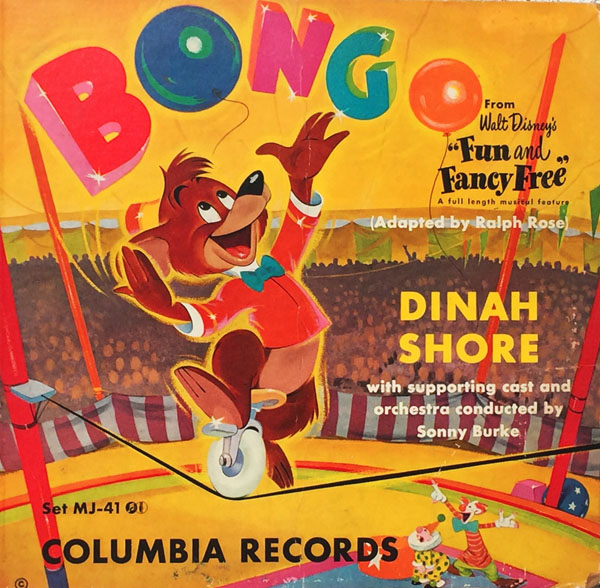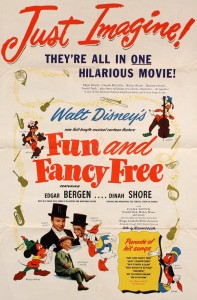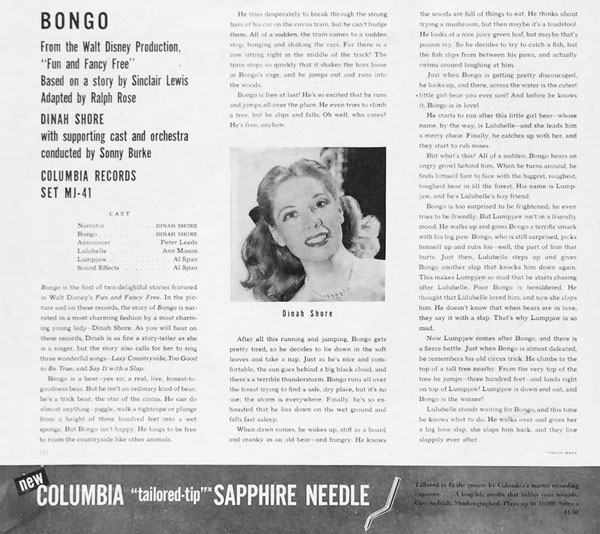This is, in a way, the record that Jiminy Cricket rolled out of its album and played when he appeared in the first half of Disney’s 1947 “package feature.”

BONGO
From Walt Disney’s “Fun and Fancy Free”
Told and Sung by Dinah Shore
Columbia Records MJ-41 (12” 33 1/3 RPM / Mono / 1947)
CD Reissue (2004): DRG Records, “Clooney Tunes / Bongo / Piccolo, Saxie & Company”
Recorded July 27-28, 1947. Adapted by Ralph Rose. Based on “Little Bear Bongo” by Sinclair Lewis. Conductor: Sonny Burke. Sound Effects: Al Span. Running Time: 17 minutes.
Voices: Dinah Shore (Narrator, Bongo, Vocalist); Peter Leeds (Announcer); Ann Mason (Lulubelle); Al Span (Lumpjaw).
Songs: “Lazy Countryside” by Buddy Kaye, Bobby Worth, Eliot Daniel; “Too Good to Be True” by Buddy Kaye, Bobby Worth; “Say It With a Slap” by Eliot Daniel.
Underscore: “Bongo” by Bobby Worth.
 To the record collector, seeing a record being played on a vintage phonograph in classic Disney animation is quite a treat. That’s what happens at the beginning of the Disney feature Fun and Fancy Free, a dual-segment package film from 1947. There couldn’t be more of a direct connection between what audiences saw on screen and what they could pick up at their favorite record store (after listening to it in one of those cool old booths they had back then).
To the record collector, seeing a record being played on a vintage phonograph in classic Disney animation is quite a treat. That’s what happens at the beginning of the Disney feature Fun and Fancy Free, a dual-segment package film from 1947. There couldn’t be more of a direct connection between what audiences saw on screen and what they could pick up at their favorite record store (after listening to it in one of those cool old booths they had back then).
Dinah Shore had already vocalized “Two Silhouettes” for Make Mine Music, but now she was in the more prominent position of narrator. A major recording star during WWII with decades of career transitions ahead of her–including musical variety TV stardom, talk show hosting and sponsoring a woman’s golf tournament—she was a big name to attach to an animated feature during the less-than-salad days of the Disney studio, when full-length features were not possible.
As she and her musical contemporaries had done in Make Mine Music, Shore offered the synergy of her appearance on radio shows, allowing her to promote the film and sing the songs. This is not unlike today’s employment of celebrity voices in order to assist in marketing on talk shows and in the press.
There’s just one little issue, though. Bongo is kind of a blah story. Perhaps the prestige of Pulitzer Prize-winning Sinclair Lewis added oomph to the publicity, but Bongo is basically a country mouse/city mouse yarn with bears. The character design and color styling of the segment is very appealing—in fact, Bongo himself comes off better in storybooks and comics than he does on film. As a lead, he’s not very sympathetic, despite all the attempts to make him endearing. Lulubelle and Lumpjaw don’t come across any better—though Dinah Shore’s spirited narration provides a much-needed amount of warmth and friendliness.
Then there’s that whole slapping thing. Maybe real bears like slapping each other, like puppies like to nip. But these are anthropomorphic animals who slap as a gesture of love and it’s jarring even by 1940’s standards. Such behavior was an element of Rodgers and Hammerstein’s Carousel too–the abuse inflicted by the antihero is strangely perceived by his wife and daughter in similar terms–but this 1945 musical (and the play upon which it was based), is a complex adult character study, not a whimsical family romp. Suffice it to say that “Say it with a Slap” isn’t likely to be featured in a new theme park parade or “We Love Disney” recording.
The songs are very pleasant, especially “Lazy Countryside,” also recorded by Bill Hayes, who would have a number one hit with Disney’s “Ballad of Davy Crockett.” The tunes are very much of their time, perhaps by design, as the studio needed the boost of jukebox hits. It’s worth noting that Eliot Daniel, who also wrote the lyric to “Lavender Blue,” did the same for the I Love Lucy theme—and Buddy Kaye penned goofball lyrics for the otherwise delightfully daffy I Dream of Jeannie (which were never heard on the series). Listen to this:
In addition, the recording is conducted by arranger/songwriter Sonny Burke, who would work with Peggy Lee on the songs for Disney’s Lady and the Tramp.
GIVE A LITTLE LISTEN
“Bongo” (Followed by Outtake)
Following the recording, listen for the cute little outtake in which Shore flubs her lines. The laughter that follows it is likely from the production team as well as the musicians; since in those days, each side of the six records was was recorded “live” with the orchestra, like a radio show. They didn’t record her voice separately and mix it in later.
Next week: Part Two of Fun and Fancy Free



 GREG EHRBAR is a freelance writer/producer for television, advertising, books, theme parks and stage. Greg has worked on content for such studios as Disney, Warner and Universal, with some of Hollywood’s biggest stars. His numerous books include Mouse Tracks: The Story of Walt Disney Records (with Tim Hollis). Visit
GREG EHRBAR is a freelance writer/producer for television, advertising, books, theme parks and stage. Greg has worked on content for such studios as Disney, Warner and Universal, with some of Hollywood’s biggest stars. His numerous books include Mouse Tracks: The Story of Walt Disney Records (with Tim Hollis). Visit 






















































The Bongo segment was later re-dubbed by Cliff Edwards for a “Disneyland” TV program titled “Jiminy Cricket Presents Bongo.” The show opens like the beginning of “Fun and Fancy Free” with Jiminy singing “I’m a Happy Go Lucky Fellow.” Two more cartoons are mixed in–a Figaro cartoon and “Chicken Little” before the Bongo story. When Jiminy plays the record album, it says “narrated by Jiminy Cricket” on the label (instead of “by Dinah Shore” as on the original). In addition to telling the story, Jiminy sings some of the songs, such as “A Bear Likes to Say it with a Slap.” It’s interesting to watch, especially to compare to the original film.
Also note that on the DVD of “F and FF” the language option for French offers a complete version of the film in French, including a popular French actress of the time narrating the “Bongo” segment.
Greg:
That WAS a cute outtake of Miss Dinah.She was a long time favorite of mine.Another great post! Thanks for sharing!
But then, why (oh-why) does EVERY human (myself included) detest that first half of Fun and Fancy Free (but adores the 2nd!)?
You’re not alone! Edgar Bergman’s section certainly takes the film into a different direction than before, and I often think this was what gave me a better appreciation of MST3K when I first saw it, it was like having the guys from F&FF heckling the films on screen!
Still, I though Bongo was OK for what they wanted to go with there. Blah story but excellent designs.
“Fun and Fancy Free” introduced me as a kid to records and record players.
I’m sure it has done for many, though I already knew of them before I saw F&FF in the 80’s, they were still commonplace to find.
Never heard this one in years since it was on Kiddie Records Weekly site. This story was only released on 3 78 RPM records, and it was never available on a 10″ LP and, 45 RPM and on one of the later releases on Columbia’s Harmony label in album form along with another story on side 2, or if they can put more songs on the other side, it should’ve put it on the album.
Andybody know the artist who illustrated the beautiful cover art??
That WAS a cute outtake of Miss Dinah. She was a long time favorite of mine. Another great post! Thanks for sharing!